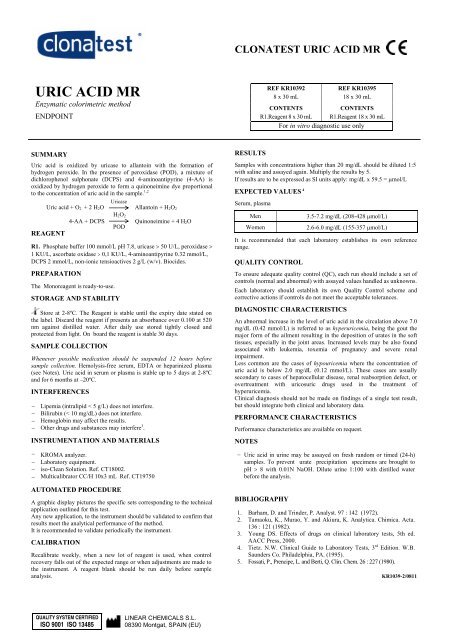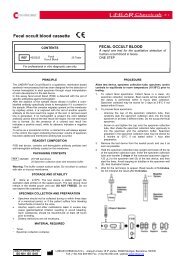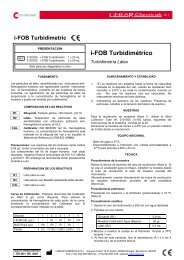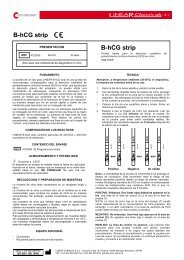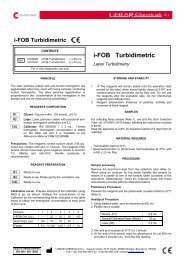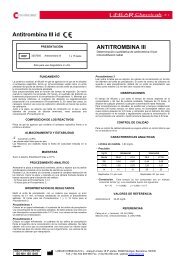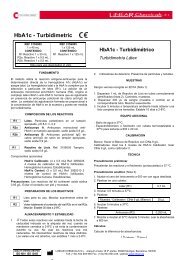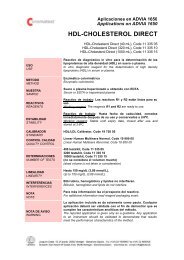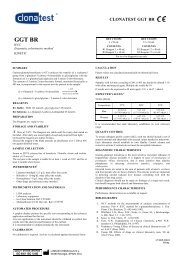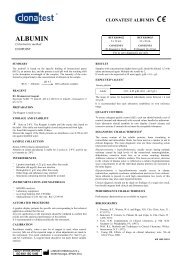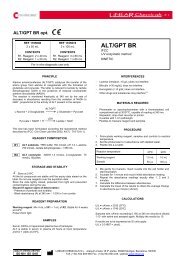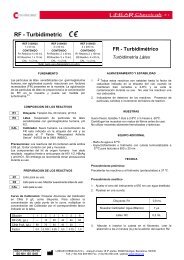You also want an ePaper? Increase the reach of your titles
YUMPU automatically turns print PDFs into web optimized ePapers that Google loves.
CLONATEST <strong>URIC</strong> <strong>ACID</strong> <strong>MR</strong><br />
<strong>URIC</strong> <strong>ACID</strong> <strong>MR</strong><br />
Enzymatic colorimetric method<br />
ENDPOINT<br />
REF KR10392<br />
REF KR10395<br />
8 x 30 mL 18 x 30 mL<br />
CONTENTS<br />
CONTENTS<br />
R1.Reagent 8 x 30 mL R1.Reagent 18 x 30 mL<br />
For in vitro diagnostic use only<br />
SUMMARY<br />
Uric acid is oxidized by uricase to allantoin with the formation of<br />
hydrogen peroxide. In the presence of peroxidase (POD), a mixture of<br />
dichlorophenol sulphonate (DCPS) and 4-aminoantipyrine (4-AA) is<br />
oxidized by hydrogen peroxide to form a quinoneimine dye proportional<br />
to the concentration of uric acid in the sample. 1,2<br />
Uricase<br />
Uric acid + O 2 + 2 H 2 O Allantoin + H 2 O 2<br />
H 2 O 2<br />
4-AA + DCPS<br />
Quinoneimine + 4 H 2 O<br />
POD<br />
REAGENT<br />
R1. Phosphate buffer 100 mmol/L pH 7.8, uricase > 50 U/L, peroxidase ><br />
1 KU/L, ascorbate oxidase > 0,1 KU/L, 4-aminoantipyrine 0.32 mmol/L,<br />
DCPS 2 mmol/L, non-ionic tensioactives 2 g/L (w/v). Biocides.<br />
PREPARATION<br />
The Monoreagent is ready-to-use.<br />
STORAGE AND STABILITY<br />
Store at 2-8ºC. The Reagent is stable until the expiry date stated on<br />
the label. Discard the reagent if presents an absorbance over 0.100 at 520<br />
nm against distilled water. After daily use stored tightly closed and<br />
protected from light. On board the reagent is stable 30 days.<br />
SAMPLE COLLECTION<br />
Whenever possible medication should be suspended 12 hours before<br />
sample collection. Hemolysis-free serum, EDTA or heparinized plasma<br />
(see Notes). Uric acid in serum or plasma is stable up to 5 days at 2-8ºC<br />
and for 6 months at –20ºC.<br />
INTERFERENCES<br />
−<br />
−<br />
−<br />
−<br />
Lipemia (intralipid < 5 g/L) does not interfere.<br />
Bilirubin (< 10 mg/dL) does not interfere.<br />
Hemoglobin may affect the results.<br />
Other drugs and substances may interfere 3 .<br />
INSTRUMENTATION AND MATERIALS<br />
−<br />
−<br />
−<br />
−<br />
KROMA analyzer.<br />
Laboratory equipment.<br />
iso-Clean Solution. Ref. CT18002.<br />
Multicalibrator CC/H 10x3 mL Ref. CT19750<br />
AUTOMATED PROCEDURE<br />
A graphic display pictures the specific sets corresponding to the technical<br />
application outlined for this test.<br />
Any new application, to the instrument should be validated to confirm that<br />
results meet the analytical performance of the method.<br />
It is recommended to validate periodically the instrument.<br />
CALIBRATION<br />
Recalibrate weekly, when a new lot of reagent is used, when control<br />
recovery falls out of the expected range or when adjustments are made to<br />
the instrument. A reagent blank should be run daily before sample<br />
analysis.<br />
RESULTS<br />
Samples with concentrations higher than 20 mg/dL should be diluted 1:5<br />
with saline and assayed again. Multiply the results by 5.<br />
If results are to be expressed as SI units apply: mg/dL x 59.5 = μmol/L<br />
EXPECTED VALUES 4<br />
Serum, plasma<br />
Men<br />
Women<br />
3.5-7.2 mg/dL (208-428 μmol/L)<br />
2.6-6.0 mg/dL (155-357 μmol/L)<br />
It is recommended that each laboratory establishes its own reference<br />
range.<br />
QUALITY CONTROL<br />
To ensure adequate quality control (QC), each run should include a set of<br />
controls (normal and abnormal) with assayed values handled as unknowns.<br />
Each laboratory should establish its own Quality Control scheme and<br />
corrective actions if controls do not meet the acceptable tolerances.<br />
DIAGNOSTIC CHARACTERISTICS<br />
An abnormal increase in the level of uric acid in the circulation above 7.0<br />
mg/dL (0.42 mmol/L) is referred to as hyperuricemia, being the gout the<br />
major form of the ailment resulting in the deposition of urates in the soft<br />
tissues, especially in the joint areas. Increased levels may be also found<br />
associated with leukemia, toxemia of pregnancy and severe renal<br />
impairment.<br />
Less common are the cases of hypouricemia where the concentration of<br />
uric acid is below 2.0 mg/dL (0.12 mmol/L). These cases are usually<br />
secondary to cases of hepatocellular disease, renal reabsorption defect, or<br />
overtreatment with uricosuric drugs used in the treatment of<br />
hyperuricemia.<br />
Clinical diagnosis should not be made on findings of a single test result,<br />
but should integrate both clinical and laboratory data.<br />
PERFORMANCE CHARACTERISTICS<br />
Performance characteristics are available on request.<br />
NOTES<br />
− Uric acid in urine may be assayed on fresh random or timed (24-h)<br />
samples. To prevent urate precipitation specimens are brought to<br />
pH > 8 with 0.01N NaOH. Dilute urine 1:100 with distilled water<br />
before the analysis.<br />
BIBLIOGRAPHY<br />
1.<br />
2.<br />
3.<br />
4.<br />
5.<br />
Barham, D. and Trinder, P. Analyst. 97 : 142 (1972).<br />
Tamaoku, K., Murao, Y. and Akiura, K. Analytica. Chimica. Acta.<br />
136 : 121 (1982).<br />
Young DS. Effects of drugs on clinical laboratory tests, 5th ed.<br />
AACC Press, 2000.<br />
Tietz. N.W. Clinical Guide to Laboratory Tests, 3 rd Edition. W.B.<br />
Saunders Co. Philadelphia, PA. (1995).<br />
Fossati, P., Prencipe, L. and Berti, Q. Clin. Chem. 26 : 227 (1980).<br />
KR1039-2/0811<br />
QUALITY SYSTEM CERTIFIED<br />
ISO 9001 ISO 13485<br />
LINEAR CHEMICALS S.L.<br />
08390 Montgat, SPAIN (EU)
CLONATEST <strong>URIC</strong> <strong>ACID</strong> <strong>MR</strong><br />
<strong>ACID</strong>O <strong>URIC</strong>O <strong>MR</strong><br />
Método enzimático colorimétrico<br />
PUNTO FINAL<br />
REF KR10392<br />
REF KR10395<br />
8 x 30 mL 18 x 30 mL<br />
CONTENIDO<br />
CONTENIDO<br />
R1.Reactivo 8 x 30 mL R1.Reactivo 18 x 30 mL<br />
Sólo para uso diagnóstico in vitro<br />
FUNDAMENTO<br />
El ácido úrico es oxidado por la acción de la uricasa, en alantoina y<br />
peróxido de hidrógeno. En presencia de peroxidasa (POD) la mezcla de<br />
diclorofenol sulfonato (DCFS) y 4-aminoantipirina (4-AA) se condensan<br />
por acción del peróxido de hidrógeno, formando una quinonaimina<br />
coloreada proporcional a la concentración de ácido úrico en la muestra. 1,2<br />
Uricasa<br />
Acido úrico + O 2 + 2 H 2 O Alantoina + H 2 O 2<br />
H 2 O 2<br />
4-AA + DCFS<br />
Quinonaimina + 4 H 2 O<br />
POD<br />
REACTIVO<br />
R1. Tampón Fosfatos 100 mmol/L pH 7,8, uricasa > 50 U/L, peroxidasa ><br />
1 KU/L, ascorbato oxidasa > 0,1 KU/L, 4-aminoantipirina 0,32 mmol/L,<br />
DCFS 2 mmol/L, tensioactivos no-iónicos 2 g/L (p/v). Biocidas.<br />
PREPARACION<br />
El Monoreactivo está listo para su uso.<br />
ALMACENAMIENTO Y ESTABILIDAD<br />
Conservar a 2-8ºC. El Reactivo es estable hasta la fecha de caducidad<br />
indicada en la etiqueta. Después de su uso diario, mantener bien cerrado y<br />
protegido de la luz. Desechar el reactivo cuando presente una absorbancia<br />
superior a 0,100 a 520 nm frente agua destilada. En el analizador es<br />
estable 30 días.<br />
MUESTRAS<br />
Siempre que sea posible deberá suspenderse la medicación 12 horas<br />
previas a la toma de muestras. Suero libre de hemólisis, plasma<br />
heparinizado u obtenido con EDTA, y orina (ver Notas). El ácido úrico en<br />
suero o plasma es estable unos 5 días a 2-8ºC y unos 6 meses a –20ºC.<br />
INTERFERENCIAS<br />
−<br />
−<br />
−<br />
−<br />
Lipemia (intralipid < 5 g/L) no interfiere.<br />
Bilirrubina (< 10 mg/dL) no interfiere.<br />
Hemoglobina puede afectar los resultados.<br />
Otros medicamentos y sustancias pueden interferir 3 .<br />
EQUIPO ADICIONAL<br />
−<br />
−<br />
−<br />
−<br />
Analizador KROMA.<br />
Material de laboratorio.<br />
iso-Clean Solution. Ref. CT18002.<br />
Multicalibrator CC/H 10x3 mL Ref. CT19750<br />
TECNICA AUTOMATICA<br />
Una representación grafica visualiza los ajustes específicos<br />
correspondientes a la aplicación técnica diseñada para este ensayo.<br />
Cualquier aplicación nueva al instrumento deberá validarse para<br />
confirmar que los resultados cumplen las características del método.<br />
Se recomienda validar periódicamente el instrumento.<br />
CALIBRACION<br />
Recalibrar semanalmente, al cambiar el lote de reactivos, cuando los<br />
valores del control estén fuera del rango de aceptación o cuando se<br />
realicen ajustes en el instrumento. Se recomienda hacer un blanco del<br />
reactivo cada día de trabajo antes de analizar las muestras.<br />
CALCULOS<br />
Muestras con concentraciones de ácido úrico superiores a 20 mg/dL deben<br />
diluirse 1:5 con solución salina y repetir el ensayo. Multiplicar los<br />
resultados por 5.<br />
Para expresar los resultados en unidades SI: mg/dL x 59,5 = μmol/L<br />
VALORES DE REFERENCIA 4<br />
Suero, plasma<br />
Hombres<br />
Mujeres<br />
3,5-7,2 mg/dL (208-428 μmol/L)<br />
2,6-6,0 mg/dL (155-357 μmol/L)<br />
Se recomienda que cada laboratorio establezca su propio rango de<br />
referencia.<br />
CONTROL DE CALIDAD<br />
Para un control de calidad (CC) adecuado, se incluirán en cada serie<br />
controles valorados (normal y abnormal) que se tratarán como muestras<br />
problema.<br />
Cada laboratorio debe establecer su propio Control de Calidad y sus<br />
medidas correctoras cuando los controles no cumplan con las tolerancias<br />
exigidas.<br />
SIGNIFICADO CLINICO<br />
El aumento anormal de ácido úrico circulante por encima de 7,0 mg/dL<br />
(0,42 mmol/L) se conoce como hiperuricemia siendo la gota la expresión<br />
mayor de la dolencia que cursa con una saturación de ácido úrico en los<br />
fluidos corporales y la consiguiente deposición de uratos en los tejidos<br />
blandos, especialmente en las articulaciones. Aumentos elevados se hallan<br />
tambien asociados a leucemias, toxemia del embarazo y fallo renal severo.<br />
Menos comunes son los casos de hipouricemia, con concentraciones de<br />
ácido úrico inferiores a 2,0 mg/dL (0,12 mmol/L), por lo general<br />
secundarios a casos de enfermedad hepatocelular, defectos de reabsorción<br />
renal o a sobredosis de drogas uricosúricas empleadas en el tratamiento de<br />
la hiperuricemia.<br />
CARACTERISTICAS ANALITICAS<br />
Las características analíticas están disponibles bajo solicitud.<br />
NOTAS<br />
− En orina el ácido úrico puede ensayarse en muestras aleatorias o de<br />
24 horas. Para evitar la precipitación de uratos alcalinizarlas a pH > 8<br />
con NaOH 0,01 N. Diluir la muestra 1:100 con agua destilada antes<br />
del ensayo.<br />
REFERENCIAS<br />
1.<br />
2.<br />
3.<br />
4.<br />
5.<br />
Barham, D. y Trinder, P. Analyst. 97 : 142 (1972).<br />
Tamaoku, K., Murao, Y. y Akiura, K. Analytica. Chimica. Acta.<br />
136 : 121 (1982).<br />
Young DS. Effects of drugs on clinical laboratory tests, 5th ed.<br />
AACC Press, 2000.<br />
Tietz. N.W. Clinical Guide to Laboratory Tests, 3 rd Edition. W.B.<br />
Saunders Co. Philadelphia, PA. (1995).<br />
Fossati, P., Prencipe, L. y Berti, Q. Clin. Chem. 26 : 227 (1980).<br />
QUALITY SYSTEM CERTIFIED<br />
ISO 9001 ISO 13485<br />
LINEAR CHEMICALS S.L.<br />
08390 Montgat, SPAIN (EU)
Aplicaciones en KROMA<br />
Applications on KROMA<br />
<strong>URIC</strong> <strong>ACID</strong> <strong>MR</strong><br />
One reagent method<br />
Uric Acid <strong>MR</strong> (8 x 30 mL), Code KR10392<br />
Uric Acid <strong>MR</strong> (18 x 30 mL), Code KR10395<br />
USO<br />
USE<br />
METODO<br />
METHOD<br />
MUESTRA<br />
SAMPLE<br />
REACTIVOS<br />
REAGENTS<br />
CALIBRADOR<br />
STANDARD<br />
CONTROL CALIDAD<br />
QUALITY CONTROL<br />
DETERMINACIONES<br />
NUMBER OF TESTS<br />
LINEALIDAD<br />
LINEARITY<br />
NOTA<br />
NOTE<br />
NOTA DE AVISO<br />
WARNING<br />
Reactivo de diagnóstico in vitro para la determinación de ácido<br />
úrico en suero, plasma y orina.<br />
In vitro diagnostic reagent for the determination of uric acid in serum,<br />
plasma or urine.<br />
Enzimático colorimétrico.<br />
Enzymatic colorimétric.<br />
Suero libre de hemólisis, plasma heparinizado u obtenido con<br />
EDTA u orina.<br />
Serum free of hemolysis, EDTA or heparinized plasma or urine.<br />
El monoreactivo R1 esta listo para su uso.<br />
The monoreagent R1 is ready to use.<br />
<strong>Linear</strong> Multicalibrator CC/H, Code CT19750<br />
<strong>Linear</strong> Human Multisera Normal CT19800<br />
<strong>Linear</strong> Human Multisera Abnormal CT19850<br />
1200 tests/kit Code KR10392<br />
2700 tests/kit Code KR10395<br />
(no se considera el volumen muerto).<br />
(dead volume is not taken in consideration).<br />
Sin post-dilución automática: Hasta 20 mg/dL<br />
Without automatic post-dilution: Up to 20 mg/dL<br />
Para más información lea el prospecto del reactivo.<br />
For additional information read reagent packaging insert.<br />
La aplicación incluida se da solamente como pauta. Cualquier<br />
aplicación deberá ser validada con el fin de demostrar que se<br />
cumplen las características analíticas del método.<br />
The reported application is given only as a guideline. Any application<br />
to an instrument should be validated to demonstrate that results meet<br />
the performance characteristics of the method.<br />
QUALITY SYSTEM CERTIFIED<br />
ISO 9001 ISO 13485<br />
LINEAR CHEMICALS S.L.<br />
08390 Montgat, SPAIN (EU)
KROMA<br />
<strong>URIC</strong> <strong>ACID</strong> <strong>MR</strong><br />
Name N. of Standards N. of rep. Units Stability<br />
Uric Acid <strong>MR</strong> 2 1 mg/dL<br />
*<br />
* entered by the user KR10392-95-1/0907<br />
QUALITY SYSTEM CERTIFIED<br />
ISO 9001 ISO 13485<br />
LINEAR CHEMICALS S.L.<br />
08390 Montgat, SPAIN (EU)


